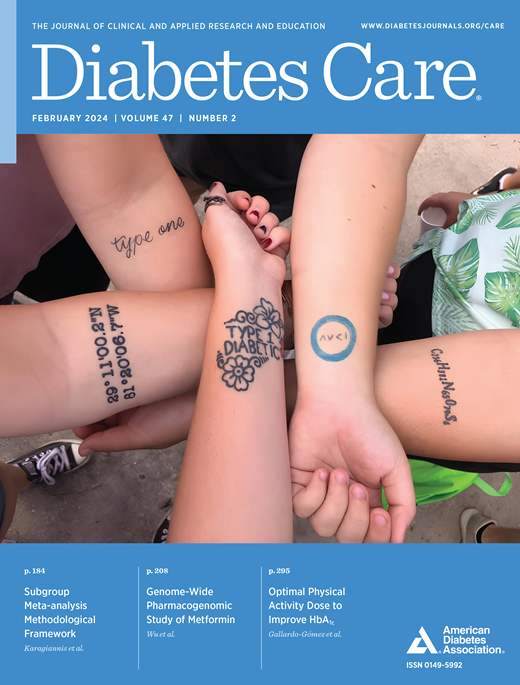Community-Based Peer Support for Diabetes Management: 24-Month Changes Relative to Comparison Communities
IF 16.6
1区 医学
Q1 ENDOCRINOLOGY & METABOLISM
引用次数: 0
Abstract
OBJECTIVE To evaluate the effectiveness of community-based peer support for diabetes self-management with HbA1c and other clinical and psychosocial outcomes over 24 months. RESEARCH DESIGN AND METHODS This study used an intervention comparison design with 12 intervention communities and 4 comparison communities matched according to location in urban or suburban areas. A community organization approach was used to integrate standardization of key messages and patient education protocols, along with adaptation and innovation among multiple community partners. The primary outcome was HbA1c; secondary outcomes included BMI, fasting plasma glucose (FPG), systolic and diastolic blood pressure, LDL cholesterol (LDL-C), depressive symptoms (PHQ-8), diabetes distress, and general quality of life (EQ-5D). RESULTS The analyses included 967 participants completing both the baseline and follow-up assessment. Intervention communities versus comparison communities were older (mean age 66.43 vs. 63.45 years), included more women (57.1% vs. 45.5%), and had longer diabetes duration (mean 7.95 vs. 6.40 years). Significant improvements were found for HbA1c (7.42% [58 mmol/mol] vs. 7.95% [63 mmol/mol]), BMI (25.31 vs. 25.94 kg/m2), FPG (7.91 vs. 8.59 mmol/L), and depressive symptoms (PHQ-8 score 1.39 vs. 1.41), favoring intervention communities, after adjusting for baseline values of outcome measures and confounders (P ≤ 0.028). No interactions were found with age (<65 vs. ≥65 years). Men showed modestly greater diastolic blood pressure reduction, and women showed a minor increase of LDL-C in intervention communities. These analyses by age or sex and sensitivity analyses with missing data imputation supported the robustness of findings. CONCLUSIONS Culturally adapted and appropriate community-based peer support for diabetes management may improve clinical and psychosocial outcomes at 24 months among people with diabetes.以社区为基础的同伴支持糖尿病管理:相对于比较社区24个月的变化
目的评估基于社区的同伴支持对糖尿病自我管理的有效性,包括24个月的糖化血红蛋白和其他临床和社会心理结果。研究设计与方法本研究采用干预比较设计,12个干预社区和4个对照社区根据城市或郊区的地理位置进行匹配。采用社区组织方法整合关键信息和患者教育协议的标准化,以及多个社区合作伙伴之间的适应和创新。主要终点为HbA1c;次要结局包括BMI、空腹血糖(FPG)、收缩压和舒张压、低密度脂蛋白胆固醇(LDL- c)、抑郁症状(PHQ-8)、糖尿病困扰和总体生活质量(EQ-5D)。分析包括967名完成基线和随访评估的参与者。干预社区与对照社区相比年龄更大(平均年龄66.43岁对63.45岁),女性患者更多(57.1%对45.5%),糖尿病病程更长(平均7.95年对6.40年)。在调整结果测量和混杂因素的基线值(P≤0.028)后,HbA1c (7.42% [58 mmol/mol] vs. 7.95% [63 mmol/mol])、BMI (25.31 vs. 25.94 kg/m2)、FPG (7.91 vs. 8.59 mmol/L)和抑郁症状(PHQ-8评分1.39 vs. 1.41)均有显著改善,有利于干预社区。未发现与年龄的相互作用(65岁vs.≥65岁)。在干预社区中,男性的舒张压下降幅度略大,女性的LDL-C略有上升。这些按年龄或性别进行的分析以及缺失数据输入的敏感性分析支持了研究结果的稳健性。结论:文化适应和适当的社区同伴支持糖尿病管理可以改善糖尿病患者24个月时的临床和社会心理结局。
本文章由计算机程序翻译,如有差异,请以英文原文为准。
求助全文
约1分钟内获得全文
求助全文
来源期刊

Diabetes Care
医学-内分泌学与代谢
CiteScore
27.80
自引率
4.90%
发文量
449
审稿时长
1 months
期刊介绍:
The journal's overarching mission can be captured by the simple word "Care," reflecting its commitment to enhancing patient well-being. Diabetes Care aims to support better patient care by addressing the comprehensive needs of healthcare professionals dedicated to managing diabetes.
Diabetes Care serves as a valuable resource for healthcare practitioners, aiming to advance knowledge, foster research, and improve diabetes management. The journal publishes original research across various categories, including Clinical Care, Education, Nutrition, Psychosocial Research, Epidemiology, Health Services Research, Emerging Treatments and Technologies, Pathophysiology, Complications, and Cardiovascular and Metabolic Risk. Additionally, Diabetes Care features ADA statements, consensus reports, review articles, letters to the editor, and health/medical news, appealing to a diverse audience of physicians, researchers, psychologists, educators, and other healthcare professionals.
 求助内容:
求助内容: 应助结果提醒方式:
应助结果提醒方式:


